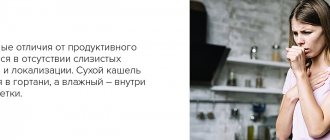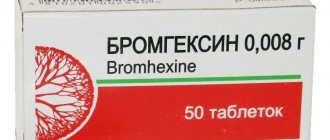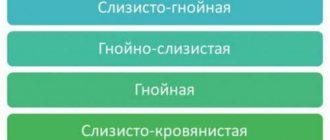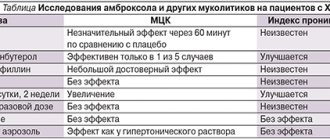Causes and types of cough with sputum
Some diseases lead to coughing with sputum. One of them is asthma. In the initial stages of the disease, mild hoarseness and a dry cough are often noted, but over time, severe wheezing and coughing with phlegm begin. Thick mucous discharge may form. Another reason may be chronic bronchitis. This disease, due to chronically blocked respiratory tracts, leads to a dry cough, which over time develops into a cough with phlegm. In this case, the sputum is likely to contain pus.
A cough with phlegm can also occur with a common cold. During this disease, there is the release of sputum, which contains mucus and pus. Inhalation of particles of paint, dust or other substances increases the formation of mucus in the respiratory tract. This mucus irritates the airways and causes coughing with phlegm. This phenomenon is often observed in people with allergies or chronic sinusitis. Lung cancer is also a likely cause of cough with sputum.
Read more: Signs, symptoms, stages and treatment of lung cancer
A chronic cough with the release of a small amount of sputum streaked with blood is a harbinger of this disease. The sputum may contain mucus or a mixture of mucus and pus. A dry cough that develops into a cough with sputum can also appear with pneumonia. The color of the sputum will change depending on the bacteria present in it.
Cough with yellow sputum
If the sputum produced when coughing is yellow, this may indicate the presence of bronchitis, pneumonia or sinusitis. If a person who rarely coughs suddenly begins to cough and produces yellow sputum, he or she should urgently seek medical help. This is especially necessary if there is pus or blood in the sputum. A yellow tint is usually formed when there is an admixture of pus in the sputum.
To identify the disease, it is necessary to perform a sputum analysis. The sputum is collected in a special jar. The procedure is carried out in the morning on an empty stomach. Before coughing, a person should rinse their mouth with a weak antiseptic solution.
A cough with yellow sputum can also be observed in experienced smokers. The nature and color of sputum may indicate the cause of bronchitis. Yellow sputum indicates the presence of a bacterial infection in the bronchi. Patients with yellow sputum when coughing should be treated by a qualified healthcare professional.
Cough with white sputum
White sputum with a curd-like consistency released during a cough may indicate a fungal infection or tuberculosis in the respiratory tract. Fungal infections of the bronchi can be caused by long-term antibiotic therapy against the background of reduced immunity, which entails the appearance of pathogenic microflora on the mucous membranes. In tuberculosis, the volume of bronchial mucus secreted is usually small.
The detection of blood in sputum is a sign of complications - pulmonary complications that appear as a result of damage to the laryngeal vessels when coughing. Sputum, which is white in color and has a watery consistency, may appear in response to exposure to external irritants, due to a viral infection or respiratory diseases. Transparent sputum when coughing indicates the absence of inflammation. Thick and clear sputum serves as a signal of incipient pneumonia, bronchitis, allergies, asthma or colds. If the volume of such sputum constantly increases, this can lead to poisoning. As a result, it should not be allowed to stagnate in the bronchi.
Cough with phlegm and blood
Bloody sputum during a cough may be evidence of a respiratory disease. If blood is detected in the sputum, you should immediately consult a doctor, who will determine the cause of this symptom and prescribe appropriate treatment. The main causes of coughing up blood include lung cancer. In this case, the patient's sputum contains blood in the form of streaks. Blood-containing sputum may also be observed in acute bronchitis.
Read more: Causes, symptoms and treatment of acute bronchitis
The volume of blood in the sputum in chronic bronchitis is usually small (these are scarlet streaks mixed with thick purulent sputum). Another reason for the appearance of such symptoms can be pneumonia. In this case, a cough with sputum containing traces of fresh blood will be characteristic. Treatment of cough with blood is carried out taking into account the cause that provoked the development of this symptom.
Prolonged cough with sputum for more than a month
A long-term cough is one that lasts more than 4-8 weeks without signs of improvement. Coughing with phlegm for a long time is an alarming symptom that may indicate the presence of serious illnesses.
This cough can be provoked not only by an inflammatory process or bronchial asthma, and therefore an x-ray of the lungs should be immediately performed. This test will help rule out cancer.
In such a case, tuberculosis cannot be ruled out (it is even one of the most likely options). Smokers with prolonged bronchitis are often susceptible to prolonged coughing with phlegm. This disease is often chronic and difficult to cure.
This type of cough can also be characteristic of people of certain professions. It usually accompanies the disease asbestosis, which occurs as a result of prolonged contact with asbestos. The treatment for this occupational disease consists of stopping contact with this substance.
Cough with phlegm in the morning
Many people cough in the morning. Often this phenomenon is nothing unusual and should not cause panic or any concern. The body just needs to remove the phlegm that has accumulated in the lungs overnight. The question lies in the fact that a healthy person does not accumulate very much sputum, and there is practically no morning cough. If the lungs produce a large volume of sputum, then there are reasons for this.
The most common causes of morning cough include smoking. Chronic morning cough is a known sign of tobacco poisoning. As you age, the effects of smoking become more intense. The cause of a morning cough can also be tuberculosis, chronic obstructive pulmonary disease, or the flow of mucus into the throat from the sinuses.
Causes of sputum
Mucus in the throat
- a natural reaction of our body to the appearance of an irritant. In this way, the body protects itself from infection: sputum increases in volume, and a person involuntarily coughs to free himself from viruses and harmful bacteria. After recovery, the amount of mucus returns to its normal, imperceptible level. If the feeling of phlegm in the throat has become constant, this may indicate a chronic ENT disease, or problems in the digestive and other systems of the body.
The causes of excess mucus can be different:
- cold;
- bronchitis;
- bronchial asthma;
- pneumonia (pneumonia);
- tuberculosis;
- sinusitis;
- chronic rhinitis;
- lung cancer.
In addition to the listed pathologies, smoking can also be a cause of sputum separation. In smokers, the mucous membrane of the respiratory tract is constantly exposed to the toxic effects of nicotine and cigarette tar. Chronic inflammation gradually provokes the production of sputum in quantities that force a person to cough every morning.
Treatment of cough with phlegm
If a person suffers from ARVI or bronchitis, if he has a cough with sputum, which is difficult to separate, then it is necessary to use drugs that have the property of thinning it (mucolytic drugs), or those that contribute to its better separation (expectorants). They can be of either plant or synthetic origin.
Most people, in an effort to maintain their health, refuse to take medications of non-natural origin. However, when giving preference to a drug based on medicinal plants, it should be remembered that they also have multiple side effects and have certain contraindications.
It is a mistake to think that the composition of plants is exclusively useful and medicinal components. They also contain toxic and harmful substances that can cause damage to health. In addition, allergies are a frequent companion of modern people. Therefore, even an expensive and seemingly effective drug can provoke a reaction that is unexpected for a sick person.
So, below we will tell you about all the medicines that can help you in treating cough with phlegm.
You cannot prescribe and use antitussives on your own. Only a doctor can recommend them. Another important rule concerns the prohibition of taking drugs from the mucolytic and antitussive groups together. An exception is when a doctor prescribes combination drugs. Such drugs combine an unexpressed antitussive and expectorant effect.
Treatment of wet cough
The choice of a treatment plan for a wet cough at the ENT-Asthma clinic, as well as the selection of medications for use by medical specialists in general, largely depends on the reasons that provoked the appearance of the cough. For colds, our experienced medical specialists with many years of experience prescribe medications that improve sputum discharge, in other words, turn an unproductive dry cough into a wet one.
For painful, unproductive and prolonged attacks, our specialist doctors can resort to treating wet cough using a set of procedures that block the cough reflex. Since a wet cough is only a symptom and not an independent disease , the most important thing is to make a correct diagnosis and prescribe adequate and effective treatment for the underlying disease in the shortest possible time.
Classification of drugs that relieve cough and promote rapid recovery
There are three types of medications aimed at relieving cough:
- A group of expectorant drugs, they are prescribed when the sputum in the respiratory organs is not thick and the cough is productive.
- Group of antitussives and drugs of combined action. They are prescribed when the patient suffers from an unproductive and dry cough, which disrupts his rest and reduces his appetite.
- Group of mucolytic agents. These drugs are prescribed if the cough is productive, but the sputum is thick and viscous, making it difficult to separate.
In turn, drugs from the group of expectorants are divided into:
- Medicines with resorptive action. Due to irritation of the bronchial mucosa, the formation of sputum increases and the person coughs it up more easily. The effect occurs after the drug is absorbed in the gastrointestinal tract.
- Medicines with reflex action. Facilitation of the removal of sputum and mucus from the bronchi occurs due to irritation of the mucous membrane lining the stomach. As a result, the patient’s vomiting center is stimulated, but he does not vomit, and the amount of mucus in the respiratory tract increases. The peristalsis of the muscles lining the bronchi increases, the epithelium covering their smaller branches moves the accumulated mucus to the larger branches.
Mucolytic agents, the action of which is aimed at liquefying sputum, in turn, are divided into:
- Agents that can affect the viscosity of bronchial secretions and the elasticity of this mucus. Such means include, for example, ACC.
- Drugs that can speed up the release of mucus from the bronchi. These include, for example, Ambroxol and Bromhexine.
- Means that help ensure that mucus is formed in smaller quantities, for example, medications such as M-anticholinergics, Libexin Muco and glucocorticoids.
Which doctors should I contact about a cough?
To determine the causes of cough, diagnose the condition and treat it, you must consult a therapist or pediatrician. If your cough doesn't go away within a few weeks, make an appointment with a pulmonologist or gastroenterologist (if you have acid reflux or established GERD).
A cough that occurs due to a cold or flu usually goes away on its own. You need to drink as much fluid as possible and get plenty of rest; to relieve pain and reduce high fever, you can take paracetamol or ibuprofen (attention: you should not give aspirin to children to reduce fever, its use is associated with the development of Reye's syndrome).
The effectiveness of multi-ingredient over-the-counter cough and cold medications in relieving symptoms is questionable. Research shows that not only do they not improve the condition, but they may have potentially serious side effects. They may also contain paracetamol and may cause an overdose if you are already taking it. It is not recommended to give over-the-counter multi-ingredient cough and cold medicines to children under 12 years of age. Cough lozenges (for children over 4 years old) and honey (for children over 1 year old), humidification and ventilation of the room can alleviate the condition.
Reflex cough expectorants
Thermopsis after preparing the infusion can cause vomiting in a child, even if the dose is slightly exceeded. In addition, cytisine, which is part of the infusion, can provoke a short-term stimulation of breathing in a child with subsequent depression of respiratory function.
Preparations Althea
- Indications. Prescribed for acute and chronic pathologies of the respiratory system. Diagnoses are pulmonary emphysema, tracheobronchitis, bronchitis and obstructive bronchitis. The clinical sign for prescribing the drug is viscous sputum with difficult separation.
- Pharmachologic effect. Liquefaction of bronchial secretions, relief of inflammation, stimulation of wave-like contractions of the walls of the bronchi, which promotes the movement of mucus to the trachea and its further removal from the respiratory tract.
- Contraindications. The presence of individual sensitivity, ulcer of the duodenum and stomach. People with a history of fructose intolerance or diabetes mellitus should take this drug, available in syrup, with caution. The possibility of use during pregnancy or under 3 years of age should be discussed with your doctor.
Mukaltin. The average price for tablets is 20 rubles. Children need to first dissolve the tablet in 1/3 glass of water. For adults, the maximum single dose is 100 mg. The product should be taken before meals, up to 3 times a day. The maximum duration of treatment is 2 weeks.
Alteika syrup (Althea syrup). The price of the product is 90-130 rubles. Take the drug orally, after diluting 1 spoon (teaspoon) of the drug in 1/4 glass of water (age - up to 12 years), or diluting 1 spoon (already a tablespoon) in 1/2 glass of water (for adults). Take up to 4 times a day. The therapeutic course is half a month, but according to the doctor’s indications it can be increased.
Marshmallow roots. The price of the drug is 60 rubles. To prepare the medicine, you need to heat a glass of water and add a tablespoon of previously crushed root. After boiling, the product is kept in a water bath for another quarter of an hour, then the resulting infusion is cooled, squeezed out and filtered. The resulting volume will need to be brought to 0.2 liters. The infusion is prepared not over direct heat, but in a water bath.
The product should be shaken before use and taken no more than 4 times a day, after each meal. Age restrictions for a single dose:
- 3-5 years – dessert spoon;
- 6-14 years – 1 or 2 tablespoons;
- over 14 years old and adults – half a glass.
Continuous therapy should not exceed 21 days.
Thermopsis preparations
Cough tablets Thermopsol. Price category - from 30 to 50 rubles.
This drug is based on the thermopsis herb. The plant has the ability to irritate the respiratory and vomiting center, promoting expectoration of phlegm.
Herbs contain a large number of alkaloids, these are:
- Cytisine;
- Methylcytisine;
- Thermopsin;
- Anagyrin;
- Thermopsidine;
- Pahikarpin.
The tablet form of the drug additionally contains sodium bicarbonate, which makes sputum less viscous and has a stimulating effect on the functioning of the bronchi.
- Indications. Viscous sputum accompanying bronchitis or tracheitis + bronchitis.
- Contraindications. Tablets are prohibited for use if there is a peptic ulcer, or individual (high) sensitivity of the body to the components of the drug.
- Application. Therapy without interruption – up to 5 days. Dosage – 1 tablet. Frequency: 3 times a day.
Codelac broncho with thyme without codeine. This elixir can be purchased for 150 rubles. It contains ambroxol, sodium glycyrrhizinate and thyme extract.
These drugs can have expectorant, anti-inflammatory and mucolytic effects, since they contain several active components.
| Indications | Contraindications | Mode of application | Side effects |
| Age up to 12 years, period of childbearing and breastfeeding, individual intolerance. Relative contraindications: bronchial asthma, peptic ulcer, liver and kidney failure. | 1 tablet 3 times a day with food |
|
5 days is the maximum period during which the drug can be taken without additional medical supervision.
Codelac Broncho does not contain codeine. The price range of the drug is between 120 and 170 rubles. This medicine contains sodium bicarbonate, thermopsis extract, glycyrrhizinate and ambroxol.
Chest charges No. 1, 2, 3, 4
| First number | Second number | Number three | Number four |
| Oregano + mother and stepmother | Mother and stepmother + plantain + licorice (sold under the name Fitopectol, maximum price - 50 rubles) | Sage + anise + marshmallow + pine buds | Chamomile + violet + wild rosemary + licorice + calendula |
Elixir Bronchofit from a Ukrainian manufacturer. The product contains plantain + wild rosemary + licorice + anise + violet + sage + thyme.
An expectorant mixture based on plantain, coltsfoot, chamomile, wild rosemary, calendula, licorice and peppermint.
- Application. Heat 0.2 liters of water and add a spoonful of the mixture. Boil the resulting mixture for a quarter of an hour and, after cooling and straining, bring it to the original volume. All manipulations are performed in a water bath. The treatment is a course, the maximum duration of therapy is half a month. Take on an empty stomach, before meals. A single dose is 1/4 cup, the number of doses per day is 4.
- Undesirable reactions of the body that may occur in response to taking the drug: allergies, stool disorders, nausea and heartburn.
Ledum, plantain, coltsfoot and other medicinal plants.
Wild rosemary herb. The price of the medicine does not exceed 35 rubles. This plant is a component of many expectorant mixtures, including collection number four and Bronchophyte. Local irritation to the bronchi is caused by the essential oils contained in the plant. In addition, the herb helps relieve inflammation, has an antimicrobial effect and promotes stimulation of the myometrium and the central nervous system.
- Side effects. Dizziness, increased irritability and excitability, as well as the development of bronchospasm are possible.
- Mode of application. Two tablespoons are poured into 0.2 liters of boiling water and left to infuse. You need to drink half a glass up to 3 times a day.
Plantain leaf, the maximum price of the medicine is 30 rubles.
Action of the plant:
- anti-inflammatory;
- antibacterial;
- laxative;
- mucolytic;
- expectorant;
- improving the functionality of the ciliated epithelium.
Such an extensive list of medicinal effects is achieved thanks to the composition of the plant leaf.
| Composition of plantain | Indications for use | Mode of application | Contraindications | Side effects |
| Essential oil, vitamins, mucus, biologically active, tannins and bitter substances, alkaloids, saponins and resins, flavonoids and phytoncides, mannitol, chlorophyll, sterols, oleic acid, microelements, macroelements | Atherosclerosis, inflammatory processes of the upper respiratory tract, diseases of the gastrointestinal tract and renal system, bronchitis, whooping cough, pneumonia and atopic dermatitis. | Infused and taken 2 tablespoons up to 3 times a day 30 minutes before meals | Peptic ulcer, hyperacid gastritis, allergy to plants. | Allergies, heartburn |
The therapeutic course is half a month maximum.
Coltsfoot. The price of this medicine is 40 rubles.
| When should I take it? | How to use? |
| When it is necessary to achieve expectorant, antibacterial, diaphoretic and choleretic, antispasmodic and wound-healing effects. | In a water bath (bring 0.2 liters of water to a boil and add 2 tablespoons of herbs, boil for 15 minutes), then squeeze out the infusion, bring to the original volume and consume 0.15 liters every 3 hours. Or drink 3 tablespoons half an hour before meals 3 |
Plantain syrup and mother and stepmother. The price is 200 rubles.
| How to use | Contraindications | Side effects |
| Up to 15 years 2 teaspoons, after 15 years 2 tablespoons, but already tablespoons up to 4 times a day | Stomach ulcer, childhood (up to six years), pregnancy period. | Allergy |
Maximum therapy, without doctor’s supervision – 3 weeks.
Herbion with plantain. The maximum price for the drug is 230 rubles.
Phytosyrup Stoptussin. The price of the drug is 130 rubles. The composition of the drug includes thyme, thyme and plantain.
| Indications | Contraindications | How to use |
| To relieve inflammation and improve mucus discharge | Age up to one year, pregnancy, lactation, epilepsy, head injuries, kidney and liver diseases. | Children under 5 years of age are prescribed a teaspoon up to 3 times a day. From 5 to 10 years + another teaspoon. After 10 and up to 15 years + another teaspoon. Adults take a tablespoon up to 5 times a day. |
Uncontrolled therapy should not exceed seven days.
Coldrex broncho in syrup. The maximum price of a medicine is 250 rubles.
| Compound | Indications | Contraindications | How to use | Side effects |
| Guaifenesin, benzoate, macrogol, sodium cyclamate, dextrose, red pepper tincture, racemic camphor, star anise seed oil and levomenthol | Respiratory tract diseases and difficulty in passing sputum | Peptic ulcer, age up to 3 years, individual intolerance. | From 3 to 12 years old, you can give the drug to a child once in a volume of no more than 5 ml. Take the drug every 3 hours. For adults, the single dose can be increased by another 5 ml. | Diarrhea and vomiting, abdominal pain, rash and hives. |
Thyme (thyme extract)
Thyme herb and Thyme essential oil. The price is 40 and 90 rubles, respectively.
| Indications | Contraindications | How to use | Side effects |
| When you need to provide an antimicrobial, expectorant and analgesic effect. | Prohibited for use for the same pathologies as plantain. | Boil 1 bag or 1 tablespoon of herb in 1 glass of water. Time – 15 minutes. Then the infusion is filtered, brought to the original volume and consumed 3 times a day, 1 tablespoon. All manipulations are carried out in a water bath. | Allergy |
Treatment time should not exceed three weeks.
Liquid thyme extracts have a combined (expectorant and mucolytic) effect. They are used for diagnoses - bronchitis, pneumonia, conditions in which the sputum is viscous and difficult to separate.
Among these drugs:
- Bronchicum cough lozenges cost 150 rubles, and the same remedy in syrup costs 250 rubles. Take after meals 2 times a day up to six years (from six months to one year - half a teaspoon, from two to 6 years - a whole teaspoon). After six years and older, the frequency of administration is 3 times a day (from six to 12 years, 1 teaspoon, then 2 teaspoons). As for lozenges, from 6 to 12 years old you can take 3 lozenges per day, adults up to 6 lozenges.
- Bronchicum TP. The composition includes not only thyme, but also primrose. Take half a teaspoon (3 times a day) throughout the day from one year to 4 years, a whole teaspoon (4 times) from five to 12 years, and a whole teaspoon for adults, but up to 6 times.
- Pertussin syrup at a price of 30 rubles. In addition to thyme, the syrup contains potassium bromide. The drug is taken after meals, from 3 to 6 years, half a teaspoon, from 6 to 12 years, a whole teaspoon, after 12 years, a dessert spoon, adults, a tablespoon. The frequency for each age is 3 times a day. The maximum therapeutic course is 3 weeks.
- Tussamag syrup or drops, the maximum price of which is 170 rubles. Children from one to 5 years of age are advised to take no more than 25 drops; if necessary, they can be diluted with water. After five years - up to 50 drops, for adults - up to 60 drops. Frequency of administration – up to 4 times a day. The syrup is taken 1 teaspoon after meals (from one to five years), 2 teaspoons after 5 years, 3 teaspoons in adults. The frequency of administration is also 4 times a day.
Gelomirtol
| Indications | Mode of application | Side effects |
| Chronic and acute bronchitis | 5 times a day, 120 mg - for children under 5 years of age (if the process is in the acute phase), 3 times a day if the process is in the chronic phase. For adults, 30 minutes before meals in a dosage of 300 mg up to 4 times a day in the acute phase of the disease and in the same dosage, but 2 times a day in the chronic course of the disease. If the disease has entered the chronic stage, then you can use 300 mg before a night's rest. This measure will facilitate the passage of sputum in the morning. | Dyspeptic disorders, abdominal pain, allergies, increased mobility of gallstones. |
About wet cough
Among the most common reasons for seeking medical help in the autumn and winter, the leading place is occupied by a wet cough.
Cough is a protective reflex that occurs in response to mechanical or chemical irritation of the lower respiratory tract and laryngeal receptors. A wet cough can be a symptom of one of the serious diseases such as: allergic rhinitis, bronchitis, pneumonia, lung cancer, congestive heart failure. Video: types and causes of cough
Doctors call a wet or moist cough a certain concept - “productive”, since with a wet cough there is a result - mucus from the bronchi moves out. The human body begins to independently cope with the cleansing of phlegm - this is how the healing process is carried out.
A wet cough accompanies respiratory tract infections such as acute respiratory viral infections and acute respiratory infections . Sometimes it happens that with an allergic rhinitis, a wet cough appears as a response to mucus that gets from the nose into the larynx. Sputum can form during bronchitis and pneumonia. All diseases associated with the formation of a wet cough require competent, comprehensive and effective treatment.
Cough expectorants with direct resorptive action
Sodium and potassium iodide, sodium bicarbonate, ammonium chloride increase sputum production. Ledum, oregano and other herbs, as well as essential oil of anise fruits, have a similar effect.
Amtersol. The composition of the drug includes ammonium chloride, thermopsis extracts of licorice root, potassium bromide, sodium benzoate.
- Contraindications. Breastfeeding, pregnancy, under 3 years of age, hypersensitivity and stomach ulcers.
- Application. Take after meals, up to 3 years of age, half a teaspoon, from 6 years, a whole teaspoon, from 12 years, a dessert spoon, from 18 years, a tablespoon. The frequency of administration is 3 times a day. The therapeutic course should not exceed two weeks.
Mucolytic cough suppressants for bronchitis
The group of these drugs helps to make sputum more liquid, the process of its elimination improves, and as a result, favorable conditions for the life of pathogenic organisms are disrupted.
Acetylcysteine
- Vicks asset priced at 280 rubles. Release form: soluble tablets.
- Fluimucil costs 240 rubles. Release forms vary. These can be granules, ampoules and tablets.
- ACC in packaged form or in tablet form. Price up to 400 rubles.
These drugs contribute to the frequency of exacerbations in chronic bronchitis. Laryngitis, pneumonia, otitis media and all forms of bronchitis can be taken.
- Contraindications. Age up to 2 years, pregnancy, pulmonary hemorrhages, bronchial asthma, pathologies of the adrenal glands, liver and kidney failure.
- Application. The maximum therapeutic course should not exceed a week. The more liquid the patient drinks, the higher the expectorant effect will be. From 2 to 5 years, 100 mg no more than 3 times a day, from 6 to 14 years, 100 mg 3 times a day, 200 mg in the same dose for adults, or 600 mg once.
- By-effect. Heartburn and vomiting, increased heart rate, pulmonary hemorrhages, skin reactions - rash and urticaria, headaches, drop in blood pressure, bronchospasm and stomatitis.
Bromhexine
- Bromhexine itself in tablet form for 80 rubles, in the form of drops for 100 rubles and in the form of a mixture for 140 rubles.
- Bronchosan for 190 rubles. In addition to the main active ingredient, it contains oils: fennel, oregano, mint, eucalyptus, anise and levomenthol.
- Solvin in syrup and tablets for 120 rubles.
The effect of taking these drugs will be noticeable after a minimum of 2 days and a maximum of 5 days.
- Application. If the product is used for inhalation, it must be diluted in equal proportions with saline solution. 2 mg for children under 10 years of age, 4 mg after 10 years of age and 8 mg for adults. If a medicine is chosen, then 2 mg for children from 2 to 2 years old, 8 mg after 6 years (multiplicity for both ages - 3 times a day). In adults, up to 16 mg up to 4 times a day.
- Contraindications. The drug should not be taken in tablet form before 6 years of age, during the 1st trimester of pregnancy, during breastfeeding, or in the presence of individual intolerance.
Combined action drugs – Ascoril, Joset, Kashnol
May only be used on medical advice:
- In Joset syrup for 180 rubles.
- In Cashnol syrup at a price of 130 rubles.
- Askoril tablets cost 300 rubles, syrup costs 250 rubles.
The composition of the medicines includes Salbutamol, Bromhexine and Guaifenesin.
- Indications. Bronchial asthma, pneumonia, tuberculosis, emphysema, COPD, chronic bronchitis, tracheobronchitis.
- Dosage. From 3 to 6 years, 5 ml, up to 12 years, 5 or 10 ml, 12 years, 10 ml. The frequency of administration is 3 times a day.
- Contraindications. Age up to 3 years, bearing a child, breastfeeding, thyrotoxicosis, tachyarrhythmia, myocarditis, peptic ulcer, diabetes mellitus, liver and kidney failure, aortic stenosis. There are contraindications when taken simultaneously with antitussives, MAO inhibitors and non-selective adrenergic blockers.
- Side effects. Headaches and drowsiness, convulsions, nervous excitability, trembling of limbs, sleep disturbances. Vomiting or nausea, diarrhea, exacerbation of peptic ulcer, drop in pressure, increased heart rate, urticaria and rash, bronchospasm and pink urine.
- Under no circumstances should you drink alkaline drinks.
Ambroxol/Lazolvan
An expectorant, among which Lazolvan is recognized as the most effective.
| Indications | Contraindications | Mode of application | Side effects |
| Pneumonia, bronchitis, bronchial asthma and other respiratory tract pathologies accompanied by the presence of viscous sputum. | Pregnancy (the first trimester is absolutely prohibited), chronic kidney and liver diseases. | Tablets up to 3 times a day after meals, only for adults. In syrup for children under 2 years old, half a teaspoon (2 times a day), up to 6 years old, half a teaspoon 3 times a day, up to 12 years old, a teaspoon 3 times, adults 2 teaspoons 3 times. The therapeutic course should not exceed 5 days. It is important to drink plenty of fluids during treatment. | Diarrhea and vomiting, allergies, rash, heartburn. |
Preparations based on medicinal substances are Lazolvan costing up to 360 rubles, Ambrohexal, costing up to 100 rubles, Ambroxol, costing up to 40 rubles, Flavamed, costing up to 200 rubles, Ambrobene, costing up to 200 rubles, Ambrosan, costing up to 100 rubles and Halixol, costing up to 100 rubles.
Causes of wet cough
A wet cough appears only in diseases of the respiratory system, acting as a consequence of increased formation of bronchial secretions (with bronchial asthma and bronchitis), sweating of blood plasma from the vessels into the lungs (pulmonary edema), separation of purulent contents from the cavity (lung abscess, cavernous tuberculosis, bronchiectasis disease).
A wet cough is also called productive, as it frees the lungs from pathological contents. The type of sputum can be used to judge the nature of the disease that caused the wet cough. Glassy sputum is very similar to transparent casts from the bronchi and is secreted in bronchial asthma; sputum, which looks like rust, is discharged during pneumonia; purulent with a foul odor - with a lung abscess or bronchiectasis.
For a wet cough, antitussive drugs should not be prescribed.








